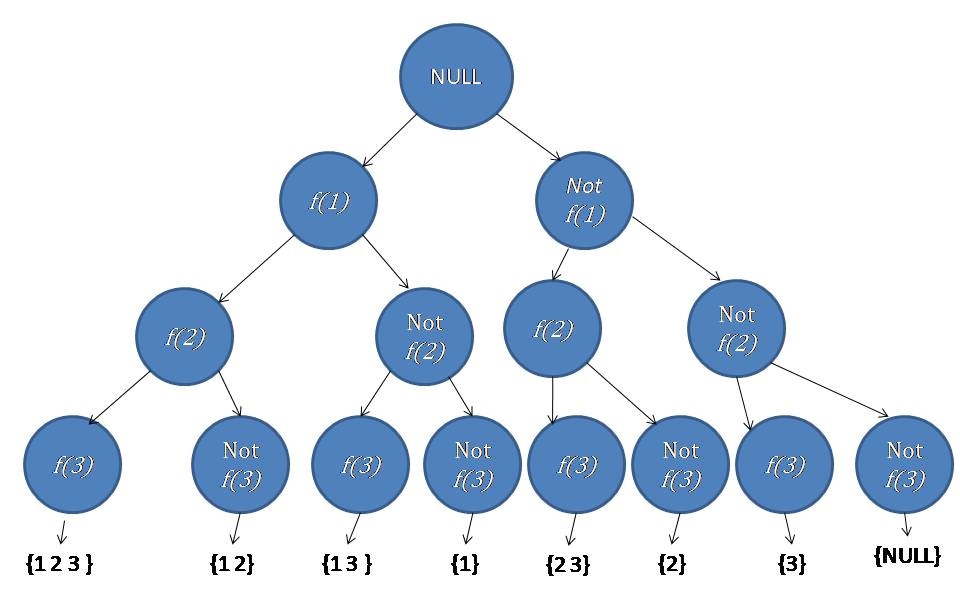Home »
Interview coding problems/challenges
Backtracking to find all subsets
Backtracking to find all subsets: Here, we are going to learn to find out the subsets of a given set of numbers using backtracking.
Submitted by Souvik Saha, on February 03, 2020
Description:
This is a standard interview problem to find out the subsets of a given set of numbers using backtracking.
Problem statement
There is a set contains N number of elements. You have to find out all the possible subsets of the given set and print them.
Input:
Test case T
//T no. of lines with the value of N and corresponding values.
E.g.
2
4
1 2 3 4
2
7 8
1<=T<=100
1<=N<=1000
Output:
Print the subsets of the set.
Example
T=2
Input:
N=4
1 2 3 4
Output:
1 2
1 2 3
1 2 3 4
1 2 4
1 3
1 3 4
1 4
2
2 3
2 3 4
2 4
3
3 4
4
Input:
N=2
7 8
Output:
7
7 8
8
Explanation with example
Let, there is a Set S having N number of elements,
S = {X1, X2, X3, ..., Xn}
The process to print the subsets of the set is a problem of combination and permutation. To get the result we use the backtracking process.
Let,
f(i) = function to insert the ith number into a subset.
Here, we take a subset of that set in our consideration and consider two things,
- An element is a part of that subset ( f(i) ).
- An element is not a part of that subset ( not f(i) ).
For: N=3
S = { 1 2 3 }

Algorithm:
Here we use the vector STL to store the subsets.
traverse(arr, n, current_pos,set,subset){
if(Current_pos is greater or equals to the n)Then
return
end if
for i = current_pos to the end of the set
insert the element of arr[i] into subset
insert the subset into the set
traverse(arr,n,i+1,set,subset)
pop the element from subset
end for
}
C++ Implementation
#include <bits/stdc++.h>
using namespace std;
void traverse(int* arr, int n, int pos, vector<vector<int> >& v, vector<int> vi)
{
//if the current position is greater than or equals to n
if (pos >= n)
return;
for (int i = pos; i < n; i++) {
vi.push_back(arr[i]);
v.push_back(vi);
traverse(arr, n, i + 1, v, vi);
vi.pop_back();
}
}
vector<vector<int> > find_subset(int* arr, int n)
{
vector<vector<int> > v;
vector<int> vi;
int pos = 0;
traverse(arr, n, pos, v, vi);
return v;
}
void print(vector<vector<int> > v)
{
for (int i = 0; i < v.size(); i++) {
for (int j = 0; j < v[i].size(); j++) {
cout << v[i][j] << " ";
}
cout << endl;
}
}
int main()
{
int t;
cout << "Test Case : ";
cin >> t;
while (t--) {
int n;
cout << "Enter the value of n : ";
cin >> n;
int arr[n];
//taking the set elements
cout << "Enter the values : ";
for (int i = 0; i < n; i++) {
cin >> arr[i];
}
vector<vector<int> > v = find_subset(arr, n);
//print the vector
print(v);
}
return 0;
}
Output
Test Case : 2
Enter the value of n : 4
Enter the values : 1 2 3 4
1
1 2
1 2 3
1 2 3 4
1 2 4
1 3
1 3 4
1 4
2
2 3
2 3 4
2 4
3
3 4
4
Enter the value of n : 2
Enter the values : 7 8
7
7 8
8
Advertisement
Advertisement